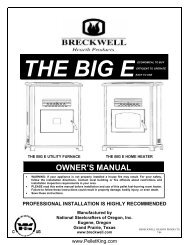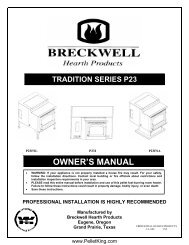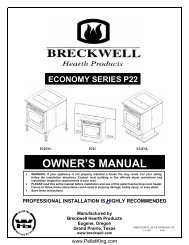INSTALLATION AND OPERATION MANUAL - Wood Pellet Stoves
INSTALLATION AND OPERATION MANUAL - Wood Pellet Stoves
INSTALLATION AND OPERATION MANUAL - Wood Pellet Stoves
You also want an ePaper? Increase the reach of your titles
YUMPU automatically turns print PDFs into web optimized ePapers that Google loves.
PLANNING YOUR <strong>INSTALLATION</strong><br />
QUESTIONS TO ASK LOCAL BUILDING OFFICIAL<br />
A correct installation is critical and imperative for reducing<br />
fire hazards and perilous conditions that can arise<br />
when wood pellet burning appliances are improperly<br />
installed. The installer must follow all of the manufacturers’<br />
instructions.<br />
The installation of this appliance must conform to local<br />
codes and applicable state and federal requirements.<br />
Familiarity with these requirements before installation is<br />
essential. Important considerations to discuss with local<br />
building officials include:<br />
1. Applicable codes (i.e. Uniform Mechanical Code,<br />
State or Regional Codes).<br />
Electrical codes:<br />
In USA, NEC, ANSI / NFPA 70 – Latest Edition<br />
In Canada, CSA C22.1 – Latest Edition<br />
Power Supply Requirements – The power cord must<br />
be plugged into a standard, 115 volt, 60 Hz grounded<br />
electrical outlet. The approximate power requirement is<br />
362 Watts, and will peak up to 736 Watts for approximately<br />
6 minutes when the self-igniter is operating (it<br />
will turn off 2 minutes after flame detection). The power<br />
cord must be routed to avoid contact with any of the hot<br />
or sharp exterior surface areas of the stove. When installed<br />
into a manufactured (mobile) home, the appliance<br />
must be electrically grounded to the steel chassis<br />
(see page 8, Manufactured [Mobile] Home Requirements).<br />
These requirements must be met unless otherwise<br />
specified by state or local authorities.<br />
WARNING - ELECTRICAL GROUNDING IN-<br />
STRUCTIONS: THIS APPLIANCE IS EQUIPPED<br />
WITH A THREE-PRONG (GROUNDING) PLUG<br />
FOR YOUR PROTECTION AGAINST SHOCK<br />
HAZARD <strong>AND</strong> SHOULD BE PLUGGED DI-<br />
RECTLY INTO A PROPERLY GROUNDED<br />
THREE-PRONG RECEPTACLE. DO NOT CUT<br />
OR REMOVE THE GROUNDING PRONG FROM<br />
THIS PLUG. DO NOT ROUTE POWER CORD<br />
UNDER OR IN FRONT OF APPLIANCE.<br />
2. Local amendments?<br />
3. Is a permit required - cost?<br />
You may wish to contact your insurance company<br />
to ask if they require this.<br />
4. Is outside combustion air required?<br />
5. Rooms where the installation is not allowed?<br />
PAGE 4<br />
www.<strong>Pellet</strong>King.com<br />
<strong>INSTALLATION</strong> / MAINTENANCE ST<strong>AND</strong>ARDS<br />
National Fire Protection Association – The primary<br />
NFPA standard that refers to installation and maintenance<br />
of pellet appliances and venting is NFPA 211 –<br />
Latest Edition: Chimneys, Fireplaces, Vents, and Solid<br />
Fuel appliances.<br />
SELECTING A LOCATION<br />
The design of your home and where you place your<br />
stove will determine its value as a source of heat. A pellet<br />
stove depends primarily on air circulation (convection)<br />
to disperse its heat, and therefore, a central location<br />
is often best. There are other practical considerations,<br />
which must be considered before a final selection<br />
of locations is made.<br />
♦ Existing Chimneys<br />
♦ <strong>Pellet</strong> Fuel Storage<br />
♦ Aesthetic Considerations<br />
♦ Roof Design (rafter locations & roof pitch)<br />
♦ Room Traffic<br />
♦ Proximity to Combustibles<br />
♦ Electrical Wiring<br />
The installation of this stove will require some research.<br />
Once your options are determined, consult with your<br />
local building department who will be able to give you<br />
the necessary installation requirements for your area (Is<br />
a building permit required? Rooms where installation<br />
may not be allowed, etc.).<br />
WARNING: CHECK ALL LOCAL BUILDING <strong>AND</strong><br />
SAFETY CODES BEFORE <strong>INSTALLATION</strong>. THE IN-<br />
STALLATION INSTRUCTIONS <strong>AND</strong> APPROPRIATE<br />
CODE REQUIREMENTS MUST BE FOLLOWED EX-<br />
ACTLY <strong>AND</strong> WITHOUT COMPROMISE. ALTERA-<br />
TIONS TO THE STOVE ARE NOT ALLOWED. DO<br />
NOT CONNECT THE STOVE TO A CHIMNEY SYS-<br />
TEM SERVING ANOTHER STOVE, APPLIANCE, OR<br />
ANY AIR DISTRIBUTION DUCT. FAILURE TO FOL-<br />
LOW THESE INSTRUCTIONS WILL VOID THE<br />
MANUFACTURERS WARRANTY.<br />
SMOKE DETECTORS<br />
Since there are always several potential sources of fire<br />
in any home, we recommend installing smoke detectors.<br />
If possible, install the smoke detector in a hallway<br />
adjacent to the room (to reduce the possibility of occasional<br />
false activation from the heat produced by the<br />
stove). If your local code requires a smoke detector be<br />
installed within the same room, you must follow the requirements<br />
of your local code. Check with your local<br />
building department for requirements in your area.






